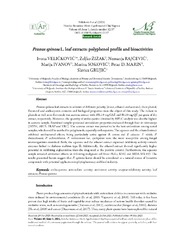Приказ основних података о документу
Prunus spinosa L. leaf extracts: polyphenol profile and bioactivities
| dc.creator | Veličković, Ivona | |
| dc.creator | Žižak, Željko | |
| dc.creator | Rajčević, Nemanja | |
| dc.creator | Ivanov, Marija | |
| dc.creator | Soković, Marina | |
| dc.creator | Marin, Petar | |
| dc.creator | Grujić, Slavica | |
| dc.date.accessioned | 2021-04-27T11:13:28Z | |
| dc.date.available | 2021-04-27T11:13:28Z | |
| dc.date.issued | 2021 | |
| dc.identifier.issn | 0255-965X | |
| dc.identifier.uri | https://www.notulaebotanicae.ro/index.php/nbha/article/view/12137 | |
| dc.identifier.uri | https://radar.ibiss.bg.ac.rs/handle/123456789/4213 | |
| dc.description.abstract | Prunus spinosa leaf extracts in solvents of different polarity (water, ethanol and acetone), their phenol, flavonoid and anthocyanin contents and biological properties were the object of this study. The richest in phenols as well as in flavonoids was acetone extract with 181.19 mg GAE and 80.10 mg QE per gram of dry extract, respectively. Moreover, the quantity of anthocyanins obtained by HPLC analysis was also the highest in acetone sample. Examined samples possessed antioxidant properties evaluated through four in vitro assays (DPPH, ABTS, FRAP and TRC). The acetone extract was proved to be the best antioxidant among tested samples, which could be ascribed to polyphenols, especially anthocyanins. The aqueous and the ethanol extract exhibited antibacterial effects, being particularly active against B. cereus and E. cloacae. T. viride, P. funiculosum, P. ochrochloron, P. verrucosum var. cyclopium were the most susceptible among fungal microorganisms examined. Both, the aqueous and the ethanol extract expressed inhibitory activity towards enzymes linked to diabetes mellitus type II. Additionally, the ethanol extract showed significantly higher potential in inhibiting α-glucosidase than the drug used as the positive control. Furthermore, the aqueous sample revealed antitumor effects on following malignant cell lines: HeLa, K562 and MDA-MB-453. The results presented herein suggest that P. spinosa leaves should be considered as a natural source of bioactive compounds with potential application in phytopharmacy and food industry. | |
| dc.publisher | University of Agricultural Sciences and Veterinary Medicine Cluj-Napoca | |
| dc.relation | info:eu-repo/grantAgreement/MESTD/inst-2020/200178/RS// | |
| dc.relation | info:eu-repo/grantAgreement/MESTD/inst-2020/200007/RS// | |
| dc.rights | openAccess | |
| dc.rights.uri | https://creativecommons.org/licenses/by/4.0/ | |
| dc.source | Notulae Botanicae Horti Agrobotanici Cluj-Napoca | |
| dc.subject | Prunus spinosa | |
| dc.subject | Anthocyanins | |
| dc.subject | Antioxidant activity | |
| dc.subject | Antitumor activity | |
| dc.subject | Enzyme-inhibitory activity | |
| dc.subject | Leaf extracts | |
| dc.title | Prunus spinosa L. leaf extracts: polyphenol profile and bioactivities | |
| dc.type | article | en |
| dc.rights.license | BY | |
| dcterms.abstract | Величковић, Ивона; Жижак, Жељко; Рајчевић, Немања; Иванов, Марија; Соковић, Марина; Грујић, Славица; Марин, Петар; | |
| dc.rights.holder | © 2021 Notulae Botanicae Horti Agrobotanici Cluj-Napoca | |
| dc.citation.issue | 1 | |
| dc.citation.volume | 49 | |
| dc.identifier.doi | 10.15835/nbha49112137 | |
| dc.identifier.scopus | 2-s2.0-85104005337 | |
| dc.identifier.wos | 000639294300001 | |
| dc.citation.apa | Veličković, I., Žižak, Ž., Rajčević, N., Ivanov, M., Soković, M., Marin, P. D., et al. (2021). Prunus spinosa L. leaf extracts: polyphenol profile and bioactivities. Notulae Botanicae Horti Agrobotanici Cluj-Napoca, 49(1), 12137. | |
| dc.citation.vancouver | Veličković I, Žižak Ž, Rajčević N, Ivanov M, Soković M, Marin PD, Grujić S. Prunus spinosa L. leaf extracts: polyphenol profile and bioactivities. Not Bot Horti Agrobot Cluj-Napoca. 2021;49(1):12137. | |
| dc.citation.spage | 12137 | |
| dc.type.version | publishedVersion | |
| dc.identifier.fulltext | https://radar.ibiss.bg.ac.rs/bitstream/id/8420/12137-Manuscript-51132-2-10-20210325.pdf | |
| dc.citation.rank | M23 |

